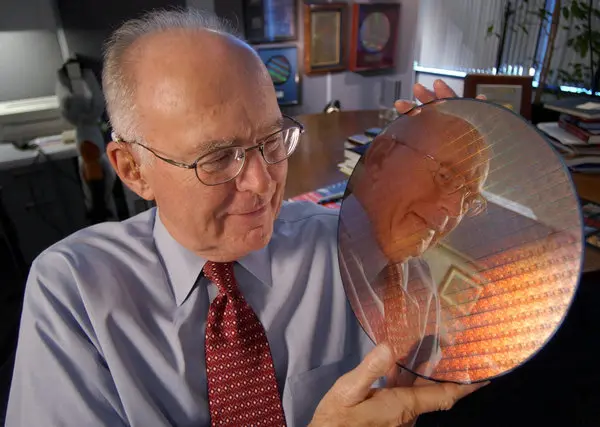Moore’s Law:
Moore’s Law has driven continuous technological innovation in semiconductor manufacturing, pushing the boundaries of what is possible.
Named after Gordon Moore (Intel’s cofounder), it refers to the observation he made in 1965 that the number of transistors on a microchip would double approximately every two years.
This prediction became a self-fulfilling prophecy, driving the semiconductor industry to continuously improve manufacturing processes and miniaturize transistors. The law has held remarkably true for several decades, leading to exponential growth in computing power and reduced cost per transistor.
Key Points of Moore’s Law :
1. Doubling Transistors: The central tenet of Moore’s Law is the doubling of transistors on a microchip every 18 months, enabling increased computing capabilities.
2. Miniaturization: Shrinking the size of transistors allows for more transistors per unit area, leading to enhanced performance and efficiency.
Challenges compelling us to think more than Moore
1. Physical Limits: The physical constraints of miniaturization are posing challenges to maintaining the pace of traditional Moore’s Law.
For perspective, one nanometer is one billionth of a meter, smaller than the wavelength of visible light. The diameter of an atom ranges from about 0.1 to 0.5 nanometers. There will be a point when the process technology can’t be scaled below the atom size. The laws of physics are to be challenged.
2. Energy Efficiency: As devices become smaller and more numerous, energy efficiency becomes a critical concern, especially in mobile and battery-powered applications.
Read More: Why Moore’s law is not a law?
More than Moore:
As the physical limits of transistor miniaturization are approached, the semiconductor industry has recognized the need for diversification beyond simply increasing transistor density.
“More than Moore” refers to a paradigm shift in semiconductor development that goes beyond the traditional focus on increasing transistor density. Instead, it emphasizes innovations in other aspects of chip design and manufacturing to meet the growing demands of diverse applications.
Key Elements of More than Moore:
1. System Integration: Rather than solely relying on transistor density, More than Moore’s strategies involve integrating various technologies and functionalities into a single system.
This integration goes beyond the core processing unit and includes components like sensors, memory, power management, and communication modules. The goal is to create more complex and capable systems that go beyond the capabilities of individual transistors.
An example of system integration can be found in modern smart home hubs (IoT devices), which bring together various technologies and functionalities into a unified system.
2. Heterogeneous Integration: Combining different technologies on a single chip, often using advanced packaging techniques, to achieve improved functionality and performance. An example of heterogeneous integration is found in modern smartphones, which combine SoCs, sensors, modems, image processing modules, communication modules, and a PMIC for each.
3. Applications Focus: Instead of pursuing a one-size-fits-all approach, More than Moore recognizes that different applications have different requirements. By tailoring chip designs to specific applications, manufacturers can optimize for factors like power consumption, processing speed, and sensor integration.
Examples include Application Specific Integrated Circuits (ASICs) like CPUs, GPUs, TPUs (Tensor processing units), and NPUs (Neural Processing units)
This approach acknowledges that not all advancements in technology need to come from a sheer increase in computing power.
Read more: How Gordon Moore Built the Most Important Company on the face of earth
Beyond Moore’s Law:
As the challenges of maintaining Moore’s Law become more apparent, the industry is actively exploring alternatives.
“Beyond Moore” addresses the challenges associated with sustaining the exponential increase in transistor density as predicted by Moore’s Law. This concept recognizes that, at some point, traditional scaling of transistors will face fundamental physical and economic limits.
These include innovations that go beyond the traditional transistor scaling model.
Key Concepts of Beyond Moore’s Law:
1. New Computing Paradigms: Exploring alternatives to traditional silicon-based transistors, such as quantum computing, neuromorphic computing, and optical computing (Silicon photonics).
Once neuromorphic chips are in mass production the leap would be there for quantum computers. Quantum computers are believed to run the calculation of a task in 200 seconds which could take the most powerful supercomputer 10,000 years to complete.
2. Advanced Materials: Investigating new materials and manufacturing techniques that can surpass the limitations of silicon.
For example, Graphene is being explored for transistor channels, interconnects, and even as a replacement for silicon in certain electronic components due to its unique properties.
3. Post-CMOS Technologies: Looking beyond complementary metal-oxide-semiconductor (CMOS) technology that has been the foundation of modern computing for decades.
Recent advancements in 3D IC (which involves stacking chips on top of each other), and Chiplet technology (distributed die system) have emerged as post-CMOS technologies to pack more transistors efficiently.
Read More: How Dennard Scaling with Moore’s Law Revolutionised Modern World
What future looks like
Shrinking transistors have powered advances in computing for more than half a century, but soon engineers and scientists must find other ways to make computers more capable. Instead of physical processes, applications, and software may help improve the speed and efficiency of computers.
Cloud computing, wireless communication, the Internet of Things (IoT), and quantum physics all may play a role in the future of computer tech innovation.




